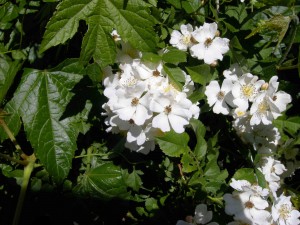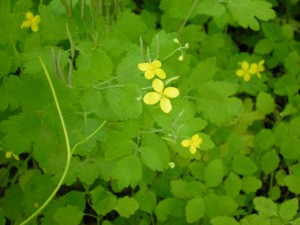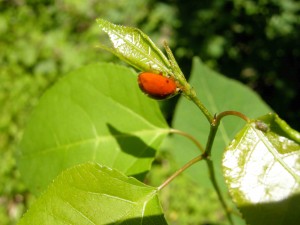On the nature trail we found a butterfly called a Spring Azure or Celastrim Ladon. It is located in North America, Canada and Alaska (North America). It got it’s name by it’s blue color (Azure) and it’s out in the spring.
Category: May
Wild Geraniums
Cinnamon Ferns
Multiflora Rose
I saw Multiflora rose on the nature trail! Multiflora rose blooms from May to June. Its habitat is borders of fields, woods, and roadsides. The range is southern New England throughout our range. It grows on prickly arching stems. The flowers are 2-3 centimeters wide. The leaves are divided into 7-9 ovate toothed leaflets about 1 inch long. The Multiflora Rose grows fruit that are a small, fleshy, and many seeded hip. Multiflora Rose grows 6-15 feet. Be careful! The stems have thorns that are curved and flattened. The flowers on this plant grows in clusters. The flowers are white and yellow with speckles on the inside.
Celandine
On the nature trail I saw a flower called Celandine. It has four petals and the color is yellow. At one point Celandine was used for liver disorders, also for removing warts and freckles. You can find Celandine in moist soil of roadsides, edges of woods, and around dwellings. Be careful – all parts of Celandine is toxic. Yellow stem juice irritates the skin!
Ladybugs
On the nature walk I saw a Ladybug. Ladybugs live almost everywhere! They can be red, orange, yellow and black. Ladybugs are very common in New England. Farmers like ladybugs because they eat aphids and aphids eat farmer’s plants. There are about 5,000 types of ladybugs. Ladybugs are related to the Japanese beetle, Hercules beetle, Boll Weevil and the Green tiger beetle. They hibernate during winter. Ladybugs are one of the most interesting beetles in the world.
Cinnnamon Fern
We made a new discovery on the nature trail. It’s the Cinnamon Fern! It is 2-3 feet tall. Spores open from April to June. Its habitat is swamps, marshes, and wet woods. Its science name is Osmunda cinnamomea. That’s what we found on the nature trail.

Red Tailed Hawk
On the weather vane on top of Abbot School, a Red Tailed Hawk sat on the W. Red Tailed Hawks have white and black feathers on their wings.The feathers are tan around the shoulders. The head is a mix of brown and white feathers. The tail, of course, is red. The underside is a pinkish color. The Red Tailed Hawk is a carnivore. It eats small mice, birds, and chipmunks. They have huge wings so they can ride the wind. Red Tailed Hawks are very big and beautiful animals.

Tree Swallows
This week on the trail we saw little bat-like figures. They were tiny Tree Swallows. They have small curved wings for gliding. Tree Swallows also have camoflauge. An enemy above would see their brown backs that blend in with the land. An enemy below would see their white bellies that blend in with the clouds. The students in room 21 wish the Swallows luck with their nests!
Wild Geraniums
I found a lavender flower that was growing on the nature trail. They ended up to be Wild Geraniums. They have deeply cut leaves and 5 petals. A Wild Geranium stem can grow up to 2 feet long. It lives in woods and meadows. The flower blooms around April through June. The flower is really small. Probably as small as a buttercup, maybe a little bit bigger. A Wild Geranium is a beautiful flower.






